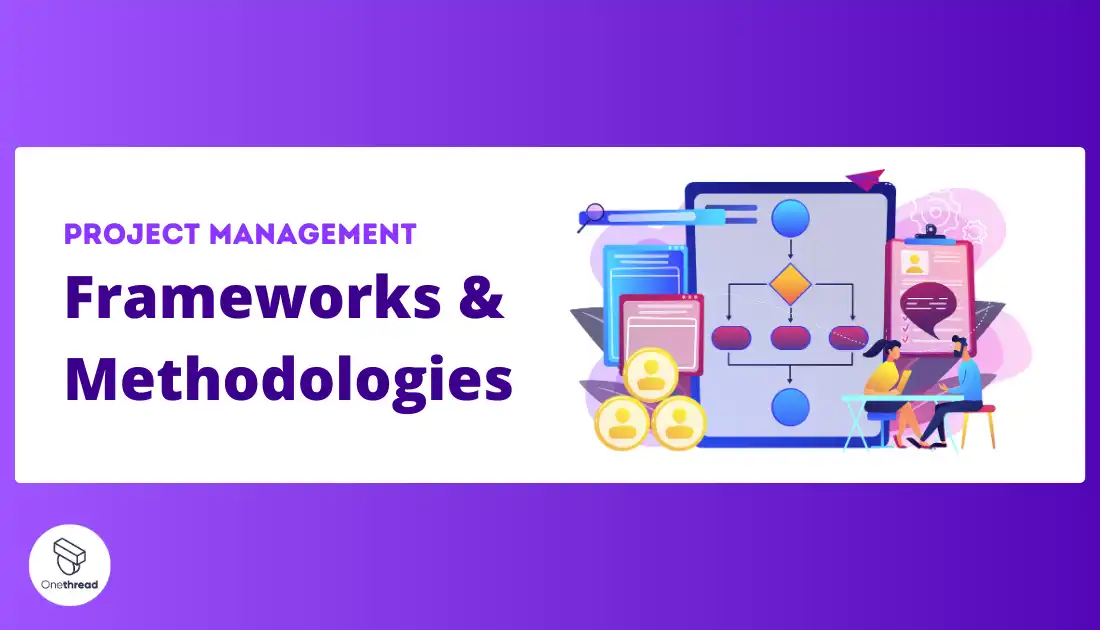Project management frameworks are your compass, guiding you toward successful project completion without rigid constraints. Choosing the right one is key, and it depends on your project’s size, industry, team’s expertise, and how predictable your needs are. These frameworks offer efficiency through standardized processes, while methodologies provide step-by-step instructions.
Think lifecycle phases, templates, and oversight – that’s the framework’s core. But before diving in, consider your project goals, team skills, planning needs, communication style, and pace.
Dive deeper in the next section to discover the perfect framework for your unique project journey!
Key Takeaways:
- A project management framework provides structured guidance for organizing, planning, and controlling projects from start to finish. Following a framework leads to more efficient execution, improved outcomes, and enhanced communication.
- Popular frameworks like Agile, Waterfall, Scrum, and Kanban each offer different approaches suited for particular project types, industries, and teams. There is no one-size-fits-all solution.
- Choosing the right framework requires analyzing your project characteristics, team capabilities, industry norms, and objectives. A framework should match the project, not vice versa.
- Implementing a framework involves steps like selecting appropriate tools, assigning roles and responsibilities, developing plans, tracking progress, and continuously improving.
- Onethread offers an affordable, easy-to-use project management platform designed specifically for startups and small companies. Its unified hub for task management, collaboration, and analytics makes it an ideal solution for teams outgrowing free tools.
Try Onethread
Experience Onethread full potential, with all its features unlocked. Sign up now to start your 14-day free trial!
What is a Project Management Framework (PMF)?
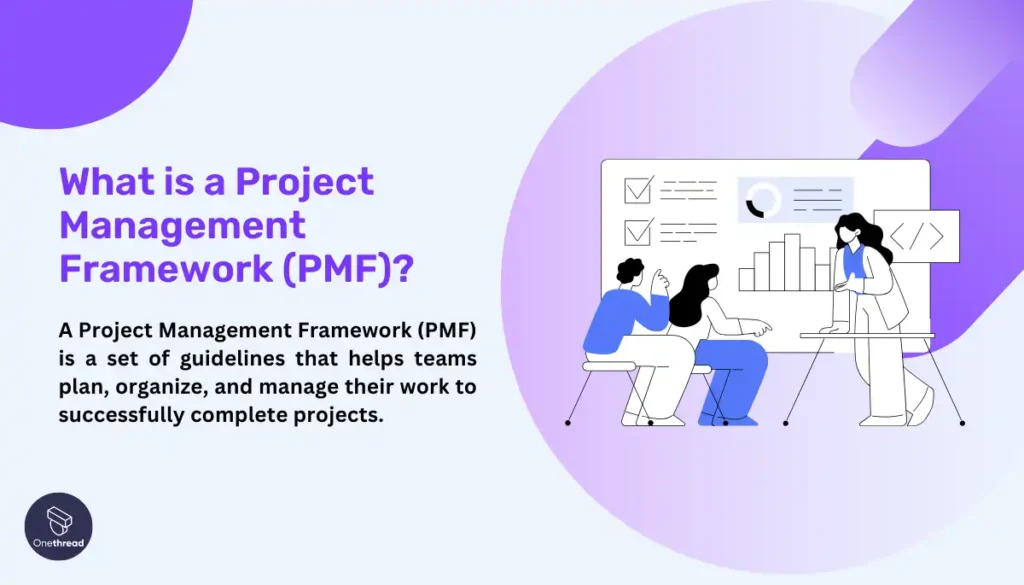
A Project Management Framework (PMF) is a set of guidelines that helps teams plan, organize, and manage their work to successfully complete projects.
It includes steps to follow, tools to use, and roles for team members, making it easier to achieve goals on time and within budget.
PMF combines practices, processes, and procedures to guide the project from start to finish. It’s like a roadmap for building a project, ensuring everyone knows what to do and when, and making teamwork smooth and efficient. This way, projects can be done well, without confusion or wasting time and resources.
Key Elements of a Project Management Framework
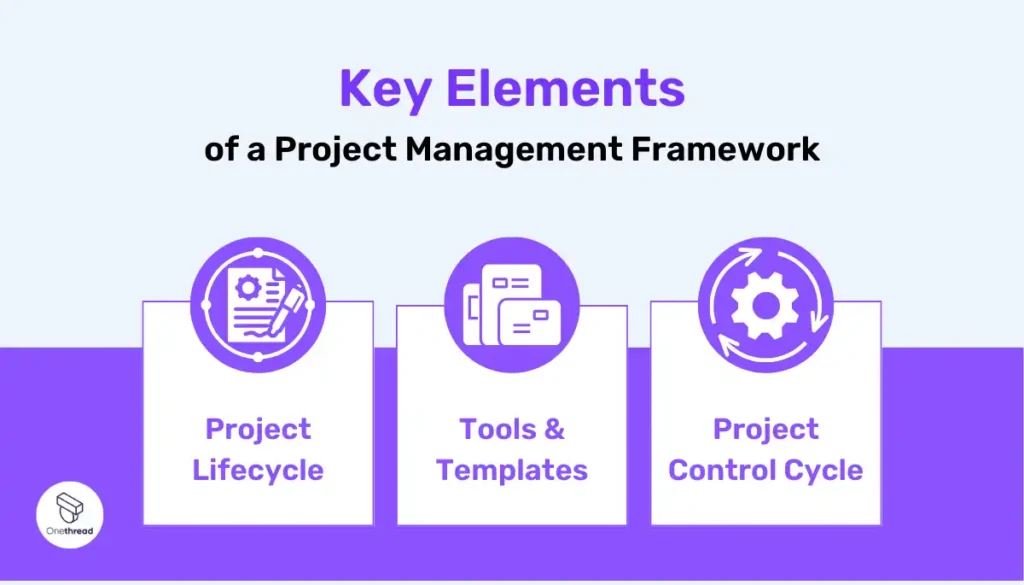
Mastering your project management journey involves diving into the core components of a Project Management Framework (PMF). This comprehensive approach ensures your projects run smoothly from start to finish.
Let’s explore the key elements:
- Project Lifecycle,
- Tools & Templates, and
- Project Control Cycle.
But before we dive in, let’s break down the framework into three key elements:
Project Lifecycle
The project lifecycle provides a structure for managing all aspects of a project from start to finish. Key phases move the project forward in a logical sequence:
- Initiation – starting up the project by defining objectives, stakeholders, and scope;
- Planning – creating detailed execution plans and budgets;
- Execution – performing planned activities to create deliverables;
- Monitoring & Controlling – tracking progress toward objectives and taking corrective actions;
- Closure – finalizing acceptance of deliverables and administrative closure.
Following this standardized sequence enables disciplined oversight in achieving project objectives on time and within budget.
Initiation:
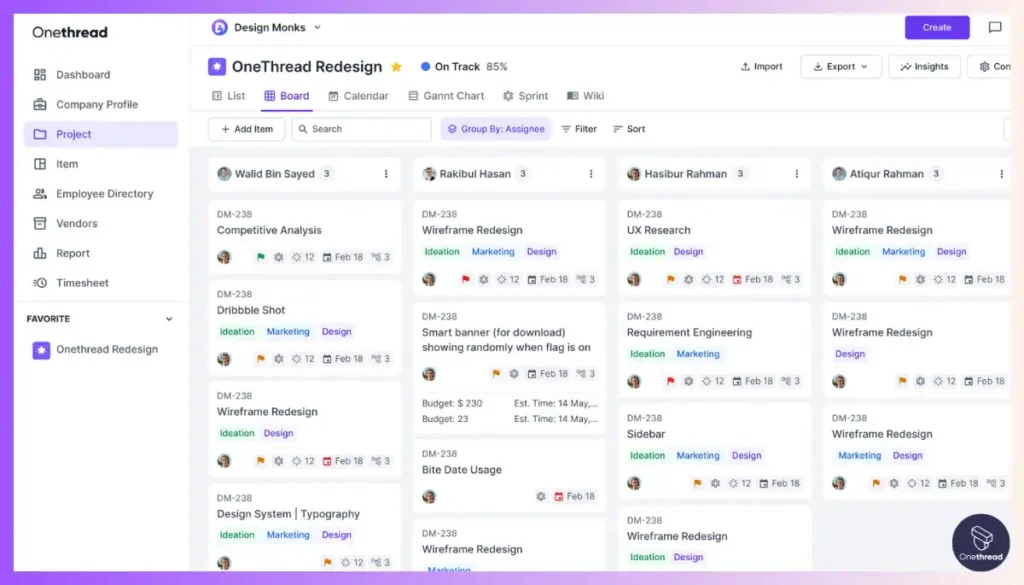
Project initiation involves starting up the project, including defining its objectives, scope, purpose, and deliverables.
Key activities include appointing a project manager and project team, conducting feasibility studies, creating the business case, securing financing, and defining requirements and desired outcomes.
Planning:
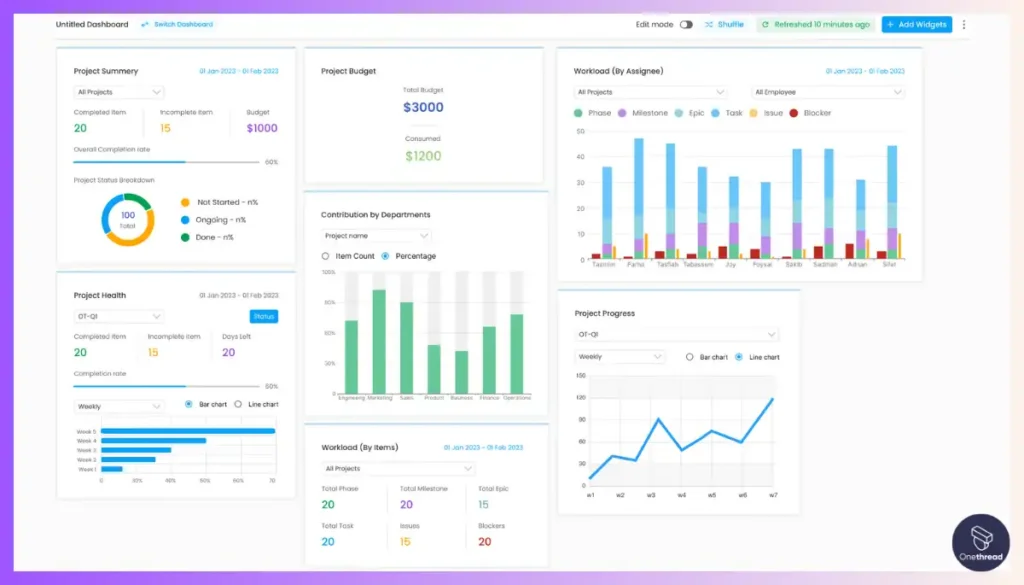
In the planning phase, the project manager works with team members to map out all project activities from start to finish.
This involves creating a work breakdown structure, schedule, budget, risk management plan, communication plan, quality plan, change management plan, and more. Detailed plans are made for executing each phase.
Onethread’s intuitive task manager lets you break down project work into manageable chunks. Assign tasks, set due dates, and dependencies, while Kanban boards visualize workflows for clear team understanding.
Execution:

With plans in place, the execution phase involves carrying out the actual work to create project deliverables. Team members perform assigned tasks, while the project manager oversees progress, resources, schedules, budgets, etc. The focus is on meeting objectives on time and on budget.
Onethread’s real-time dashboards provide a holistic view of key metrics like task completion, deadlines, and resource utilization.
Try Onethread
Experience Onethread full potential, with all its features unlocked. Sign up now to start your 14-day free trial!
Monitoring & Control:
As work is performed, monitoring and controlling processes carefully track progress to detect variances from plans. Metrics are analyzed to identify issues and needed changes. The project manager takes corrective actions as needed, manages changes through a formal process, and updates plans.
Closure:
In closure, the project manager finalizes all project activities to formally close it out.
This includes completing a final budget, training users, transferring the finished product, releasing resources, assessing project success, closing contracts, documenting lessons learned, and archiving records.
Tools & Templates
In project management, efficiency, and consistency are vital. PM tools and templates offer a structured approach to project management, eliminating the need to start from scratch for each project.
Popular methodologies like PRINCE2, CCPM (Critical Chain Project Management), Scrum, and the Waterfall methodology provide ready-to-use frameworks that cater to various project types and industries.
Gantt charts, often associated with the Waterfall methodology, are widely used for scheduling and tracking project progress.
The choice between sequential actions (ideal for Waterfall) and simultaneous actions (suitable for Kanban boards) depends on the project’s nature and requirements.
Project Control Cycle
The Project Control Cycle focuses on the ongoing monitoring and management of the project. It involves using software tools to centralize communication and track the progress of team members across different locations and time zones.
You can share customizable dashboards and reports with stakeholders instantly with modern project management software, providing them with real-time project insights and fostering transparency.
This cycle helps identify and manage risks, ensuring they are addressed proactively to avoid project derailment. Despite the challenges, effective risk management is crucial for project success.
Unfortunately, many leadership teams feel unprepared to handle risks, underscoring the importance of a project manager in navigating these challenges and keeping the project on track.
Combining these elements—Tools & Templates, the Project Lifecycle, and the Project Control Cycle—creates a comprehensive framework that guides project management from start to finish.
Why Is It Important To Use A Project Management Framework?
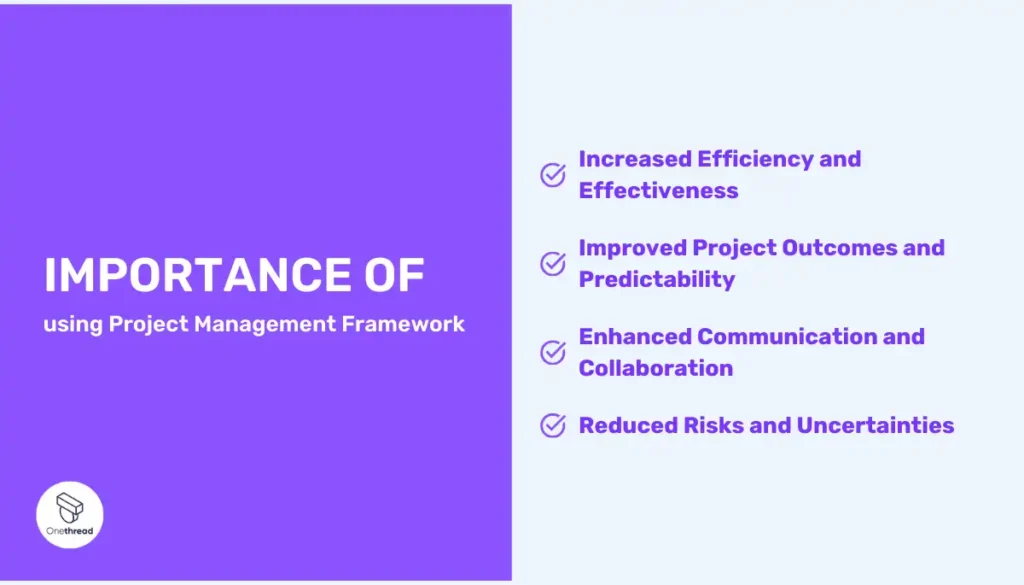
Using a project management framework is like having a secret map that guides you through the tricky world of projects. Think of it as your superhero toolkit for nailing every project you get your hands on.
Here’s why it’s a big deal, broken down into easy bits.
Increased Efficiency and Effectiveness
A project management framework streamlines the project process. It provides a clear roadmap, outlining each step from initiation to completion. This structured approach helps teams work smarter, not harder, by eliminating guesswork and redundancy.
Projects move forward smoothly, with tasks completed in a logical sequence, ensuring resources are used effectively. This efficiency not only saves time but also significantly boosts the overall effectiveness of the project team.
Improved Project Outcomes and Predictability
With a framework in place, projects are more likely to be delivered on time, within budget, and to the desired quality standards. The structured approach allows for better planning and control, which in turn, enhances the predictability of project outcomes.
Teams can foresee potential issues and address them proactively, rather than reactively, leading to more consistent and successful results.
Enhanced Communication and Collaboration
One of the pillars of a successful project is clear and open communication. A project management framework fosters an environment where information flows freely among team members and stakeholders.
Regular updates and meetings ensure everyone is aligned with the project’s goals and progress.
This transparency not only boosts morale but also encourages collaboration, as team members are more likely to contribute ideas and solutions when they understand the bigger picture.
Reduced Risks and Uncertainties
Every project comes with its share of risks and uncertainties. A project management framework includes processes for identifying, assessing, and mitigating these risks.
By anticipating potential problems, teams can devise strategies to avoid or minimize their impact, ensuring smoother project execution and reducing the likelihood of unexpected setbacks.
While there are many project management frameworks available, each with its own strengths and weaknesses, finding the right fit for your team can be challenging.
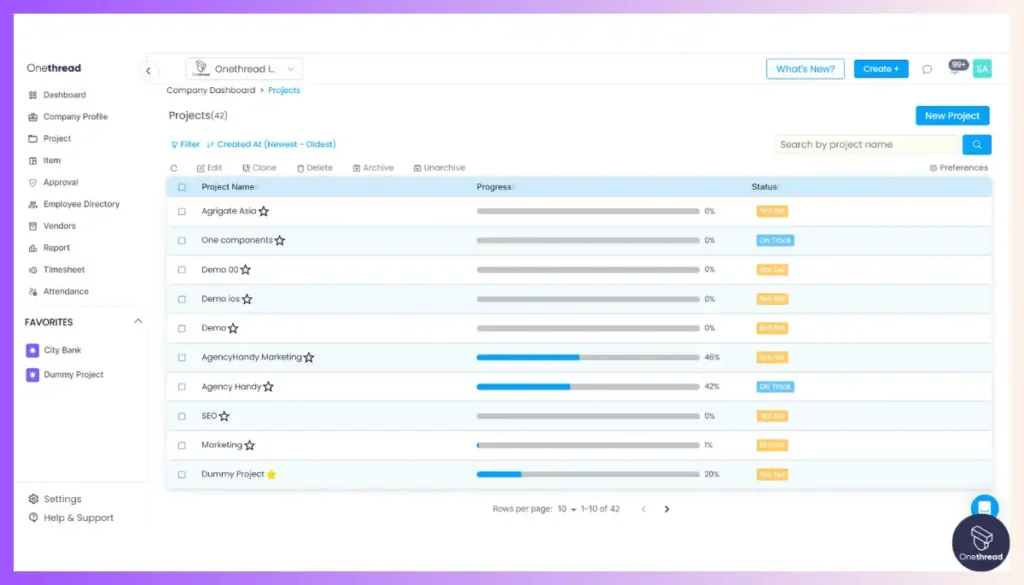
Onethread simplifies this process with its user-friendly interface and affordable pricing, making it a great option for teams of all sizes to get started with project management.
Try Onethread
Experience Onethread full potential, with all its features unlocked. Sign up now to start your 14-day free trial!
Project Management Frameworks vs. Methodologies
In the world of projects, frameworks, and methodologies are like your tools, helping you build things efficiently and successfully. But what’s the difference between them? Here is a comparison table on Project Management Frameworks vs. Methodologies:
Factors | Framework | Methodology |
Definition | Provides flexible guidance and direction without rigid rules | Has a defined set of rigid rules, processes and deliverables |
Granularity | Less detailed, more high-level | More granular and prescriptive |
Adaptability | Allows customization and flexibility | Rigid, repeatable approach |
Suitability | Better for uncertain, changing conditions | Better for defined objectives and constraints |
Expertise | Preferred by experts who can adapt it | Good for beginners who need structure |
Structured Phases | Follows project lifecycle phases | Focuses on specific methodologies |
Performance | Harder to quantify metrics | Spells out performance in detail |
Compatibility | Can embed other tools and practices | Typically not compatible with other methods |
Examples | PMBOK, PRINCE2, SAFe | Waterfall, Agile, Six Sigma |
While frameworks offer flexibility and adaptability, methodologies provide structured approaches. Integrating both can lead to optimized project management practices, ensuring success in today’s dynamic business environment.
Think of a framework as your toolbox:
It holds various tools (methods, templates, processes) that you can use for different projects. It’s like having a hammer, screwdriver, and tape measure, but you might not use them all for every project.
A methodology, on the other hand, is like a specific set of instructions:
It tells you exactly how to use your tools and in what order. It’s like having a recipe for building a sandcastle – step-by-step instructions to guide you.
So, which one do you need?
It depends on your project:
- Frameworks: Great for adaptable projects with evolving needs or uncertain outcomes. They provide structure without being too rigid.
- Methodologies: Ideal for well-defined projects with clear goals and steps. They ensure consistency and efficiency but might be less flexible.
Here’s the cool part: They work together! Frameworks give you flexibility to choose the right tools for your project, while methodologies provide a structured approach to using them. It’s like having both a toolbox and a recipe book – you can adapt the recipe to your specific needs and tools.
For example:
- Building a simple sandcastle: You might use a basic framework with tools like a bucket and shovel, following a simple “dig, pile, decorate” methodology.
- Building a complex sandcastle masterpiece: You might use a more advanced framework with specialized tools and follow a detailed methodology with specific techniques.
21 Popular Project Management Frameworks & Methodologies
Exploring 21 popular project management frameworks reveals a diverse toolkit for tackling projects across industries. Here’s a table matching the best-suited project management frameworks with various categories.
Project Management Type | Best Suited PM Frameworks |
Construction | Waterfall, Critical Path Method (CPM), PRINCE2 |
Software Development | Agile, Scrum, Extreme Programming (XP), SAFe (Scaled Agile Framework) |
Event Planning | Scrum, Kanban, Event Chain Methodology (ECM) |
Healthcare | Waterfall, PRINCE2, Six Sigma |
Manufacturing | Lean, Six Sigma, PRojects Integrating Sustainable Methods (PRiSM) |
Business Intelligence | PRINCE2, Waterfall, Agile |
Graphic Design | Agile, Kanban, Crystal |
Networking | Feature-Driven Development (FDD), Dynamic Systems Development Method (DSDM), Adaptive Project Framework (APF) |
Each framework offers unique strengths, from Agile’s flexibility to Waterfall’s structured approach, catering to varied project needs.
1. Agile
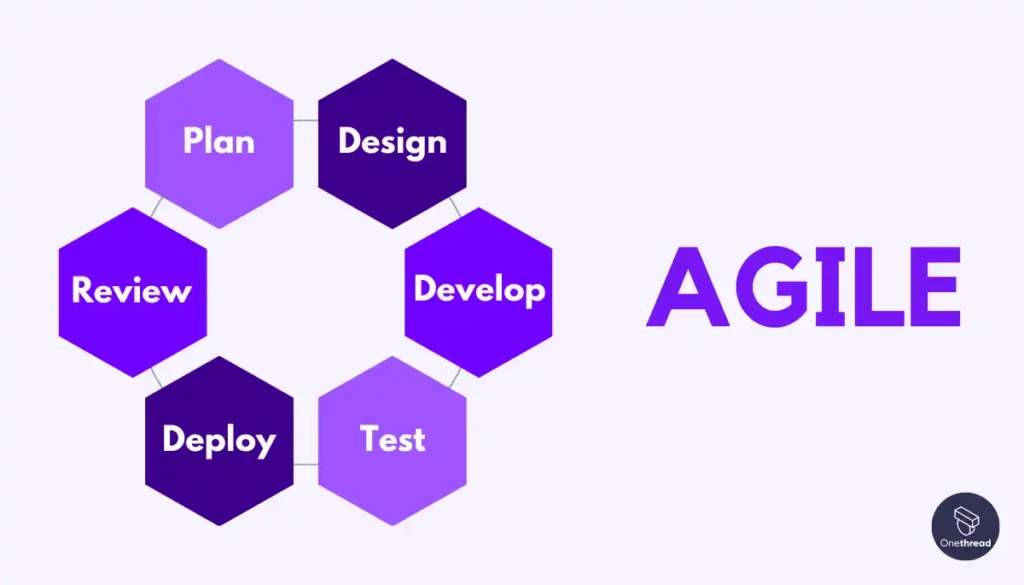
Agile is a flexible and collaborative approach to project management. It emphasizes iterative development, where requirements and solutions evolve through collaboration between self-organizing cross-functional teams. Agile promotes adaptive planning, evolutionary development, early delivery, and continual improvement, encouraging rapid and flexible responses to change.
Key Aspects
Here are three key aspects of Agile project management:
- Flexibility: Agile allows for rapid response to change, making it ideal for projects with evolving requirements.
- Incremental Delivery: Projects are divided into small, manageable units, enabling frequent releases and continuous feedback.
- Collaboration: Emphasizes teamwork and customer involvement, ensuring the final product aligns with client needs and expectations.
Pros
- High flexibility and adaptability to changes.
- Continuous delivery of value to customers.
Cons
- Less predictability in timelines and budgets.
- Can be chaotic if not well-managed.
Better Suited For Projects:
Ideal for software development and projects in dynamic environments where requirements evolve.
Not Suited For Projects:
Poor fit for projects in industries like construction or manufacturing, where changes can be costly once implementation has begun.
2. Waterfall
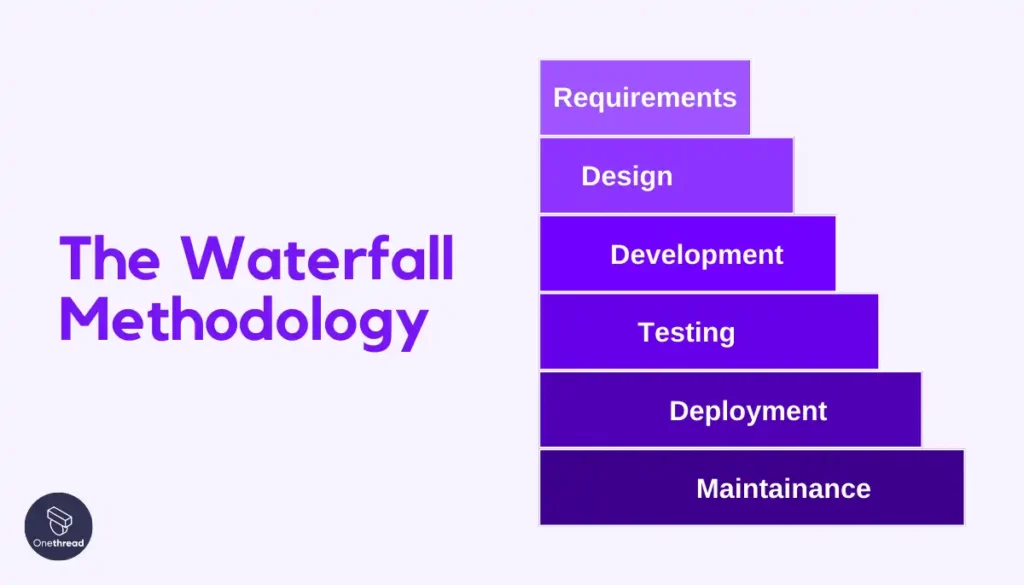
Waterfall is a structured project management methodology where tasks flow sequentially from one phase to the next. It’s characterized by a linear and sequential approach, starting with requirements gathering and documentation, followed by design, implementation, testing, deployment, and maintenance.
This method is best suited for projects with well-defined objectives and stable requirements, where changes are less likely to occur during the development process.
Key Aspects
The waterfall framework is known for its structured and sequential approach to project management, ideal for projects with well-defined requirements and deliverables.
- Sequential Phases: Projects progress through a series of distinct phases, including conception, initiation, analysis, design, construction, testing, deployment, and maintenance, without overlapping.
- Clear Documentation: Emphasizes thorough documentation at each phase, ensuring all project aspects are well-defined and understood by all stakeholders.
- Predictability: With its fixed structure, Waterfall allows for easy scheduling and budgeting, making it suitable for projects where changes are minimal.
Pros
- Clear project phases and milestones.
- Well-documented and easy to understand.
Cons
- Inflexible to changes once the project starts.
- Late testing phase can lead to discovering issues too late.
Better Suited For Projects:
Best for projects with clear, unchanging requirements, such as healthcare, and infrastructure development.
Not Suited For Projects:
Not recommended for projects in fast-paced industries where requirements are likely to change.
3. Scrum
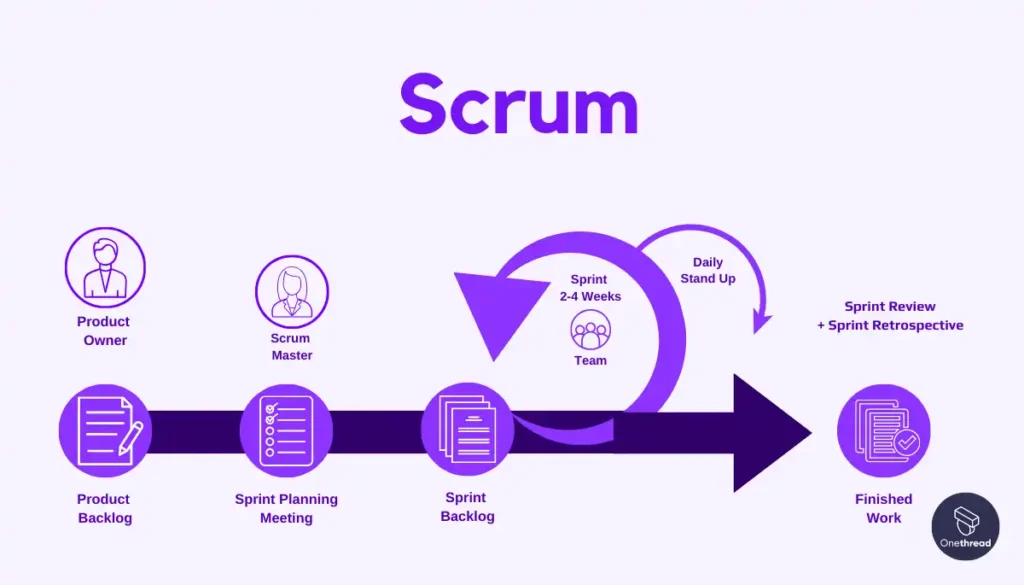
Scrum is an agile framework that breaks down large projects into manageable pieces, known as sprints, typically lasting two to four weeks. It relies on a cross-functional team working collaboratively to achieve a specific goal at the end of each sprint. Scrum encourages regular updates and feedback through daily stand-up meetings, allowing teams to adapt and make changes quickly.
In our experience with Scrum, we’ve found its structured yet flexible approach significantly enhances team productivity and project transparency. This firsthand knowledge comes from applying Scrum principles to our own project management processes, where the emphasis on continuous improvement and responsiveness to change has been a game-changer.
Key Aspects
Scrum is a popular agile framework that emphasizes flexibility, collaboration, and speed in complex project management environments.
- Sprints: Short, consistent development cycles (typically 2-4 weeks) that allow for rapid and frequent delivery of product increments.
- Roles and Ceremonies: Defined roles (Scrum Master, Product Owner, Development Team) and ceremonies (sprints, daily stand-ups, sprint reviews, retrospectives) to facilitate communication and project progress.
- Adaptability: Regular reviews and retrospectives enable continuous improvement and adaptation to changing project requirements or market conditions.
Pros
- Promotes teamwork and quick problem-resolution.
- Regular product increments and feedback.
Cons
- Requires experienced team members for best results.
- Not ideal for remote teams without adjustments.
Better Suited For Projects:
Particularly effective in software development and projects that benefit from incremental progress.
Not Suited For Projects:
Less effective for projects requiring a high degree of upfront planning and design, such as large-scale construction projects.
4. Kanban
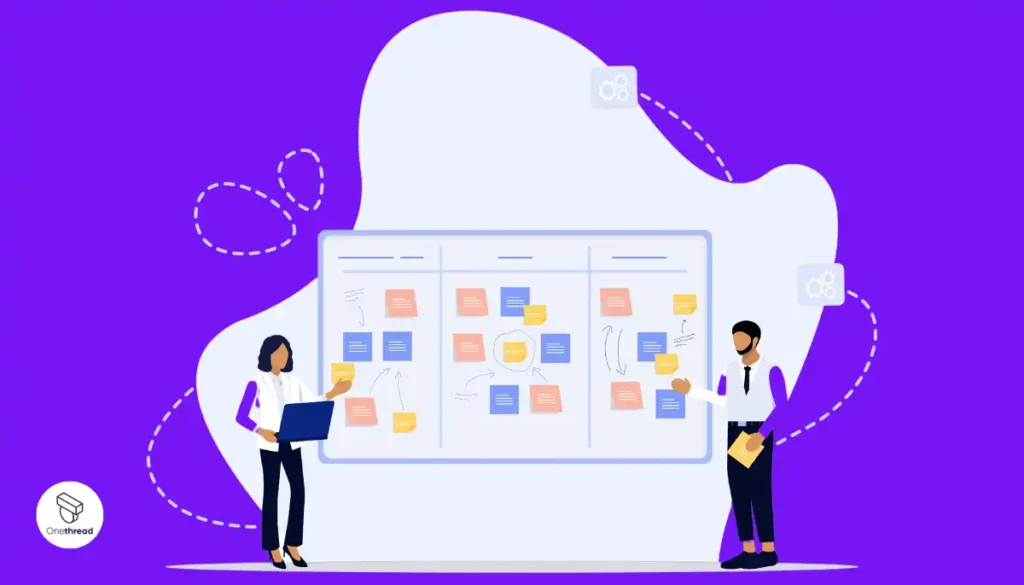
Kanban is a visual project management method that uses boards and cards to represent tasks and their progress. It emphasizes continuous delivery without overburdening the team, allowing for flexibility and efficiency.
Through our own application of Kanban, we’ve seen how its visual nature simplifies task tracking and boosts team coordination, making it easier to identify bottlenecks and prioritize tasks effectively, leading to smoother project flows and enhanced productivity.
Key Aspects
Kanban is a visual project management approach that enhances efficiency and workflow through continuous delivery.
- Visual Workflow: Utilizes a Kanban board to visualize task progress across different stages, improving clarity and tracking.
- Work-in-Progress Limits: Set limits on the number of tasks in each phase to prevent bottlenecks and improve flow efficiency.
- Continuous Improvement: Encourages regular analysis and adjustment of workflows to optimize productivity and reduce waste.
Pros
- Visualizes workflow and identifies bottlenecks.
- Flexible with changing priorities.
Cons
- Can lead to task switching if WIP limits are not enforced.
- Less focus on timelines.
Better Suited For Projects:
Great for ongoing maintenance projects or environments where priorities shift frequently.
Not Suited For Projects:
Projects that require strict phases and milestones may find Kanban’s continuous flow model challenging.
5. Scrumban
Scrumban merges the flexibility of Scrum with the visual workflow of Kanban, creating a hybrid approach that optimizes the management of project tasks. It allows for sprint planning and continuous improvement while providing a clear visual representation of work in progress.
Implementing Scrumban in our projects has streamlined our processes, offering the adaptability of Scrum with Kanban’s clarity, significantly enhancing our team’s efficiency and response to change.
Key Aspects
Scrumban combines the structure of Scrum with the flexibility of Kanban, making it a versatile project management framework.
- Hybrid Approach: Integrates Scrum’s structured sprint planning with Kanban’s continuous workflow and visualization techniques.
- Flexibility in Planning: Allows for planning on an as-needed basis, rather than fixed intervals, accommodating changing priorities more smoothly.
- Enhanced Efficiency: Utilizes Kanban boards to manage and visualize work, while incorporating Scrum’s roles and meetings to maintain focus and improve team collaboration.
Pros
- Combines the flexibility of Scrum with Kanban’s visualization.
- Ideal for maintenance and ongoing work alongside new projects.
Cons
- Can be confusing without clear guidelines.
- Balancing Scrum and Kanban elements requires experience.
Better Suited For Projects:
Ideal for teams transitioning from Scrum to a more flexible approach or for projects that start with a development phase and transition into maintenance.
Not Suited For Projects:
Not the best fit for projects that benefit from a strictly linear or highly structured approach.
6. PRINCE2
PRINCE2 is a process-based method for effective project management, offering a step-by-step approach to delivering projects with clear templates, processes, and steps. It’s known for its focus on organization and control throughout the project, from start to finish.
Our team’s adoption of PRINCE2 has significantly improved project organization and outcome predictability, demonstrating its strength in managing projects with rigor and structured guidance.
Key Aspects
PRINCE2 is a process-oriented framework that emphasizes controlled and organized project management through defined stages.
- Structured Phases: Divides projects into manageable and controllable stages, facilitating detailed planning and monitoring.
- Defined Roles and Responsibilities: Clearly outlines the roles and responsibilities of each team member, ensuring accountability and clarity throughout the project lifecycle.
- Focus on Business Justification: Includes a strong emphasis on business case development, with continual business justification and stakeholder engagement.
Pros
- Structured approach with clear roles and responsibilities.
- Emphasizes documentation and project governance.
Cons
- Can be rigid and bureaucratic.
- Requires certification for effective implementation.
Better Suited For Projects:
Large, complex projects in industries with heavy regulation, and business intelligence, such as government or finance.
Not Suited For Projects:
Small-scale or agile projects that require rapid development and flexibility.
7. Six Sigma
Six Sigma is a data-driven approach focused on reducing defects and improving quality in any process. It uses statistical methods to eliminate variability and increase performance.
Through our engagement with Six Sigma, we’ve honed our ability to pinpoint inefficiencies and streamline operations, leading to significantly enhanced project outcomes and customer satisfaction, proving its effectiveness in achieving high-quality standards.
Key Aspects
Six Sigma is a data-driven framework aimed at improving quality, reducing defects, and enhancing efficiency in processes.
- Data-Driven Decision Making: Utilizes statistical analysis to identify defects and variability in processes, aiming for near perfection.
- DMAIC Process: Follows a structured methodology—Define, Measure, Analyze, Improve, Control—to systematically improve and optimize processes.
- Focus on Quality Improvement: Prioritizes quality enhancements and customer satisfaction by minimizing errors and variability in products and services.
Pros
- Focuses on quality and process improvement.
- Data-driven decision-making.
Cons
- Requires significant training and expertise.
- Can be resource-intensive.
Better Suited For Projects:
Manufacturing and process improvement projects where quality and efficiency are paramount.
Not Suited For Projects:
Creative endeavors such as marketing campaigns or software development, where flexibility and innovation take precedence.
8. Critical path method (CPM)
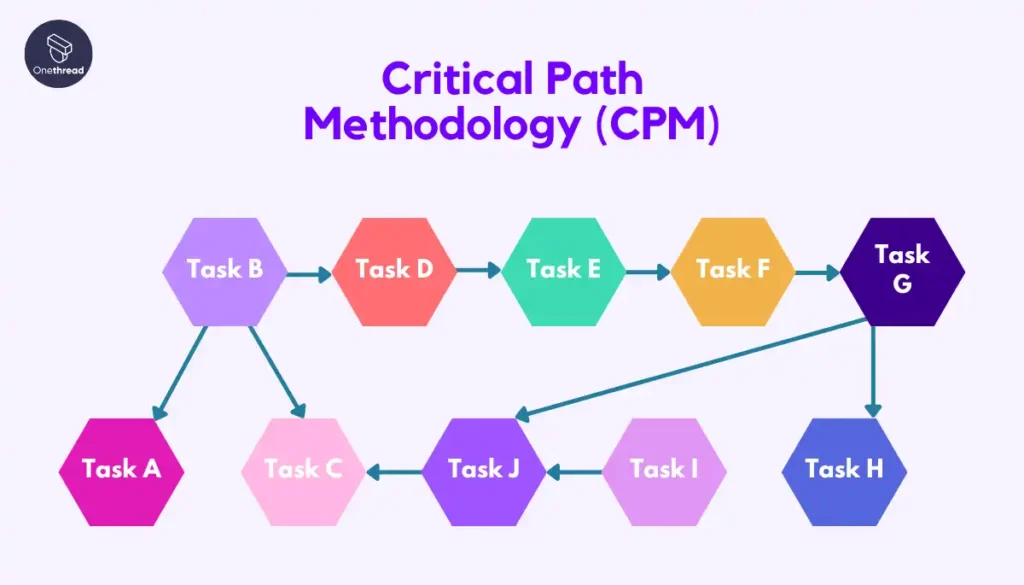
The Critical Path Method (CPM) is a project management technique that identifies key tasks essential for project completion. It focuses on the longest stretch of dependent activities and measures the time required to complete them.
Our experience with CPM has enabled us to identify bottlenecks early and allocate resources more efficiently, ensuring project deadlines are met without compromising on quality, making it a cornerstone of our project planning strategies.
Key Aspects
The Critical Path Method (CPM) is a step-by-step project management technique focused on project timing and resource allocation.
- Project Scheduling: Identifies the longest sequence of dependent tasks and calculates the minimum completion time for the project.
- Critical Path Identification: Highlights tasks that directly impact the project timeline, allowing for prioritization and efficient resource allocation.
- Flexibility in Task Management: Enables managers to see the effect of delaying or fast-tracking tasks on the overall project schedule.
Pros
- Identifies key tasks and optimizes schedules.
- Enhances resource allocation.
Cons
- Complexity increases with project size.
- Assumes fixed time estimates.
Better Suited For Projects:
Projects with well-defined tasks and dependencies, such as construction or event planning.
Not Suited For Projects:
Agile or fast-paced projects where task durations and dependencies frequently change.
9. Critical chain project management (CCPM)
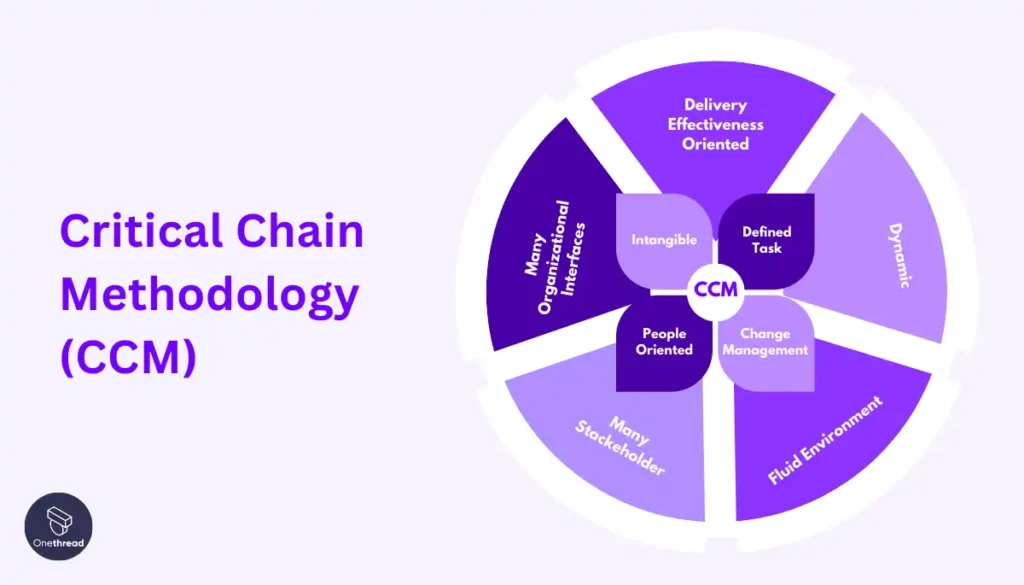
Critical Chain Project Management (CCPM) focuses on resource management and project completion times by identifying the project’s critical chain. This approach helps in prioritizing tasks based on resource availability, reducing project duration, and buffering against uncertainties.
Our adoption of CCPM has revolutionized how we manage resources, allowing us to complete projects more efficiently while maintaining flexibility for unexpected changes, showcasing its effectiveness in real-world applications.
Key Aspects
Critical Chain Project Management (CCPM) focuses on resource optimization and addressing project uncertainties.
- Resource Optimization: Prioritizes tasks based on resource availability, reducing bottlenecks and improving workflow efficiency.
- Buffer Management: Incorporates time buffers to protect against uncertainties, ensuring project deadlines are met despite unforeseen delays.
- Project Performance Improvement: Aim to enhance project completion rates by focusing on the critical chain of tasks and managing resources effectively.
Pros
- Focuses on resource optimization and flexibility.
- Reduces project duration without compromising scope.
Cons
- Requires a change in organizational mindset.
- Complex to implement with existing systems.
Better Suited For Projects:
Projects in environments where resource management is critical and timelines are tight.
Not Suited For Projects:
Projects that are less resource-constrained or where the focus is more on scope and quality rather than time.
10. Lean
Lean project management emphasizes maximizing value while minimizing waste, focusing on delivering more with less. It’s about streamlining processes, improving efficiency, and eliminating non-value-adding activities.
Implementing Lean principles has transformed our approach to projects, enabling us to deliver higher-quality results faster and more efficiently. This hands-on experience has proven Lean’s effectiveness in enhancing productivity and fostering a culture of continuous improvement within our team.
Key Aspects
Lean project management emphasizes efficiency by eliminating waste and focusing on value-added activities.
- Waste Reduction: Identifies and eliminates non-value-adding activities, streamlining processes and increasing efficiency.
- Value Maximization: Focuses on delivering maximum value to the customer, ensuring that every aspect of the project contributes positively.
- Continuous Improvement: Encourages ongoing evaluation and improvement of processes, fostering a culture of efficiency and adaptability.
Pros
- Maximizes value by eliminating waste.
- Improves efficiency and delivery speed.
Cons
- Requires continuous commitment and cultural change.
- May overlook necessary tasks seen as “waste.”
Better Suited For Projects:
Any project aiming to improve process efficiency, from manufacturing to software development.
Not Suited For Projects:
Projects where the primary goal is innovation or exploration may require more flexibility than Lean provides.
11. Project Management Institute’s PMBOK® Guide
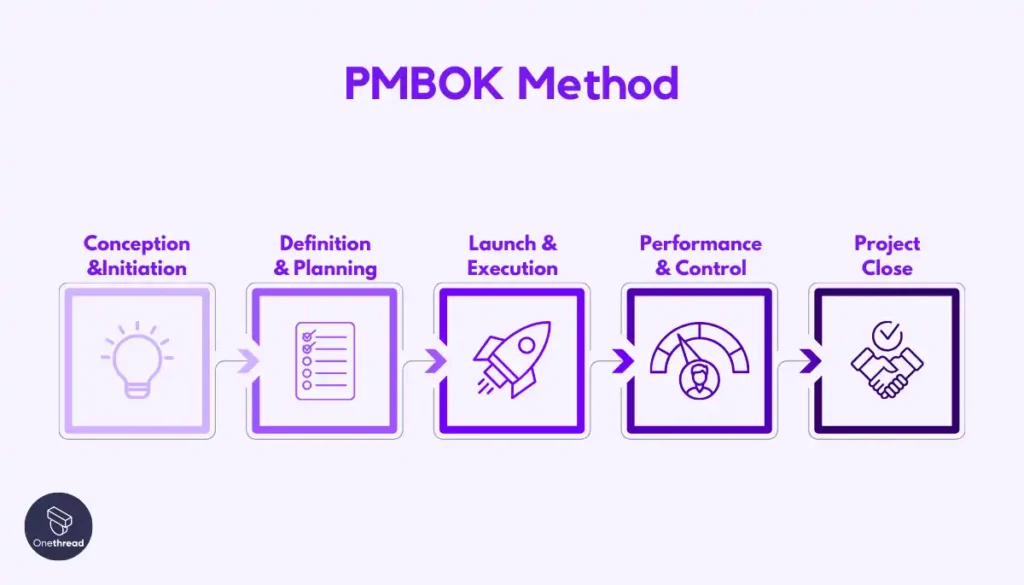
The Project Management Institute’s PMBOK® Guide is a comprehensive framework that outlines best practices and standards for project management. It covers the essential processes and knowledge areas needed to manage projects effectively.
Through applying PMBOK® principles to our projects, we’ve significantly improved our project planning and execution processes. This practical application has deepened our understanding of its methodologies, confirming its value in achieving project success and enhancing team performance.
Key Aspects
The Project Management Institute’s PMBOK® Guide outlines standardized practices and knowledge areas for effective project management.
- Standardized Practices: Provides a comprehensive set of guidelines, processes, and terminologies for managing projects efficiently.
- Knowledge Areas: Covers essential domains of project management, including scope, time, cost, quality, and risk management, facilitating a holistic approach.
- Process Framework: Organizes project management into five process groups: initiating, planning, executing, monitoring and controlling, and closing, ensuring thorough oversight and control.
Pros
- Provides a comprehensive framework and best practices.
- Widely recognized and accepted.
Cons
- Can be overwhelming for beginners.
- Flexibility may be limited by its structure.
Better Suited For Projects:
Complex projects that benefit from a structured approach and thorough documentation.
Not Suited For Projects:
Small or agile projects where the emphasis is on speed and flexibility over documentation.
12. Extreme programming (XP)
Extreme Programming (XP) is an agile framework focusing on high-quality software development through frequent releases and customer satisfaction. It emphasizes teamwork, feedback, and technical excellence.
Our team’s adoption of XP practices, such as pair programming and test-driven development, has not only improved our software quality but also fostered a collaborative environment that enhances productivity. This hands-on experience with XP has proven its effectiveness in delivering superior software solutions efficiently.
Key Aspects
Extreme Programming (XP) is an agile framework that emphasizes customer satisfaction, flexibility, and high-quality software delivery.
- Customer Satisfaction: Prioritizes customer involvement and feedback, ensuring the final product meets their needs and expectations.
- Rapid Iterations: Encourages short development cycles for faster releases, allowing for quick adjustments based on feedback.
- Quality Focus: Implements practices like pair programming, test-driven development, and continuous integration to enhance software quality and responsiveness.
Pros
- Highly adaptive to changes.
- Focuses on customer satisfaction and software quality.
Cons
- Intensive for teams, requiring close collaboration.
- Not suitable for remote teams without adjustments.
Better Suited For Projects:
Software development projects that require flexibility and have a high degree of customer involvement.
Not Suited For Projects:
Non-software projects or those where the scope and requirements are fixed and well-defined.
13. SAFe (Scaled Agile Framework)
The Scaled Agile Framework (SAFe) provides a way to scale agile methodology to larger organizations and projects. It integrates aligning, collaboration, and delivery for multiple agile teams.
Our experience implementing SAFe has significantly enhanced our large-scale project coordination, ensuring that various teams work in harmony towards common goals. This firsthand application has proven SAFe’s effectiveness in maintaining agile flexibility while providing the structure needed for large enterprise projects.
Key Aspects
The Scaled Agile Framework (SAFe) enables large organizations to apply agile and lean principles at scale.
- Scalability: Adapts agile practices for use in larger, more complex environments, allowing multiple teams to coordinate and collaborate effectively.
- Structured Guidance: Provides a comprehensive body of knowledge with clear roles, responsibilities, and processes to manage large-scale projects.
- Lean-Agile Principles: Integrates lean thinking with agile methodologies, focusing on delivering value quickly, efficiently, and with high quality.
Pros
- Scales agile for large organizations.
- Provides structure for enterprise-level project management.
Cons
- Complex to implement and requires training.
- Maybe too rigid for some agile purists.
Better Suited For Projects:
Large-scale software development projects or organizational transformations that require coordination across many teams.
Not Suited For Projects:
Small projects or teams that can achieve agility without the need for scaling frameworks. It’s about picking the right “tool” to help your project succeed.
14. Kaizen
Kaizen, originating from Japanese business philosophy, embodies continuous improvement through incremental changes. It fosters a culture of small, gradual enhancements in processes, products, and services.
Key Aspects
Here are the key aspects of Kaizen:
- Continuous Improvement: Focuses on making small, incremental changes to improve efficiency and quality continuously.
- Employee Involvement: Encourages active participation and idea generation from all levels of the organization.
- Standardization: Emphasizes standardizing processes to ensure consistency and reliability in outcomes.
Pros
- Promotes a culture of innovation and continuous improvement.
- Increases employee engagement and morale.
Cons
- Requires a cultural shift and long-term commitment.
- May lack immediate, noticeable results.
Better Suited For Projects:
Ideal for organizations seeking long-term, sustainable improvements in processes and performance.
Not Suited For Projects:
Less suitable for urgent or short-term projects requiring immediate results without substantial investment in cultural change.
15. Adaptive Project Framework (APF)
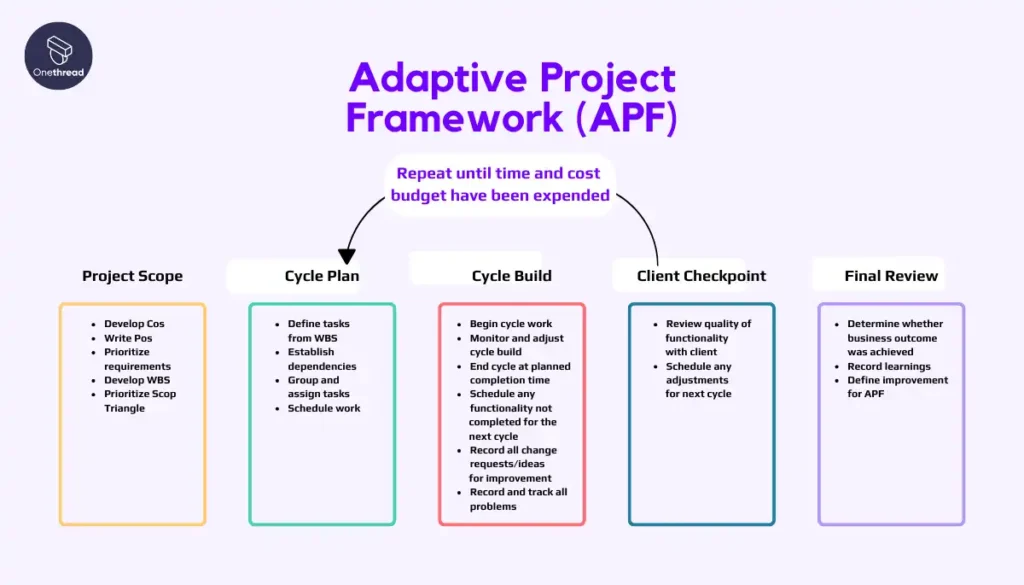
The Adaptive Project Framework (APF) is a dynamic approach to project management that prioritizes flexibility and adaptability. It focuses on adjusting project plans and resources in response to changing requirements and conditions.
Key Aspects
Fund out key characteristics of Adaptive Project Framework (APF)
- Flexibility: Emphasizes adapting project plans and strategies to accommodate evolving project dynamics.
- Customer Collaboration: Involves close collaboration with stakeholders to ensure project alignment with changing needs.
- Iterative Development: Utilizes iterative cycles to deliver incremental value and gather feedback for continuous improvement.
Pros
- Highly adaptable to changing requirements and priorities.
- Encourages stakeholder involvement and feedback throughout the project lifecycle.
Cons
- Requires experienced project managers to navigate complexity and uncertainty effectively.
- May lead to scope creep if not managed rigorously.
Better Suited For Projects:
Ideal for projects in dynamic environments where requirements are likely to change or are uncertain.
Not Suited For Projects:
Less suitable for projects with rigid timelines or well-defined deliverables.
16. Rapid Application Development (RAD)
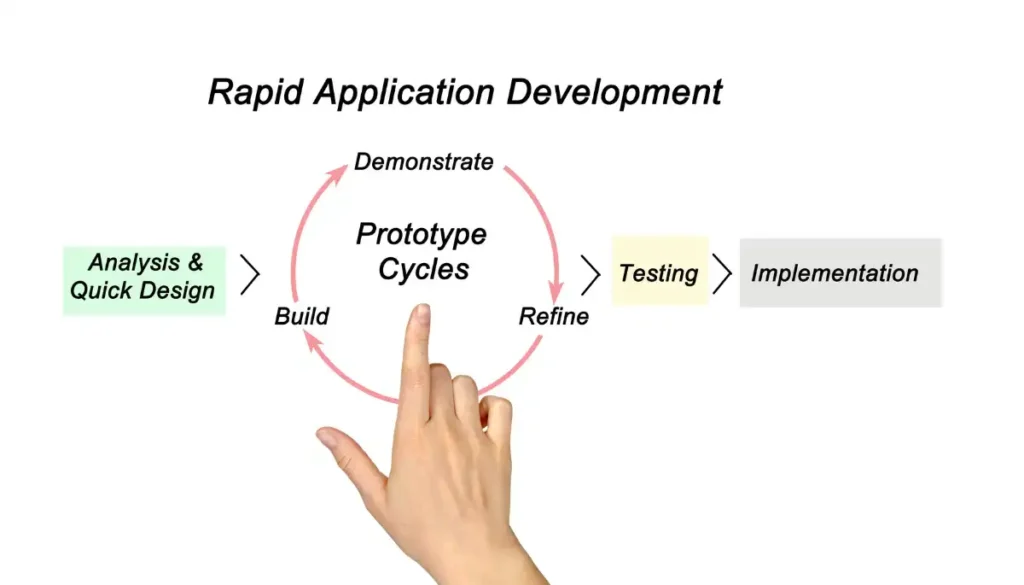
Rapid Application Development (RAD) is a methodological approach focused on the fast-paced development and delivery of software applications. It prioritizes rapid prototyping, iterative development, and close collaboration between developers and end-users.
Key Aspects
- Quick Iterations: Emphasizes rapid prototyping and iterative development to deliver working software early and often.
- User Involvement: Involves end-users in the development process to gather feedback and ensure alignment with user needs.
- Cross-Functional Teams: Encourages collaboration between developers, designers, and end-users to streamline communication and decision-making.
Pros
- Accelerates time-to-market for software applications.
- Increases customer satisfaction through early and frequent delivery of working software.
Cons
- May sacrifice long-term scalability and maintainability for speed.
- Requires experienced development teams to maintain quality in rapid delivery cycles.
Better Suited For Projects:
Ideal for projects requiring rapid development and deployment of software applications, especially in fast-paced or competitive markets.
Not Suited For Projects:
Less suitable for projects with complex requirements or strict regulatory constraints that require extensive planning and documentation upfront.
17. Crystal
Crystal is a family of agile methodologies that prioritize human interaction and communication over processes and tools. It offers a flexible approach to project management, tailoring practices to match project size, complexity, and team dynamics.
Key Aspects
Here are the main aspects of Crystal:
- Human Interaction: Emphasizes collaboration, communication, and trust among team members to drive project success.
- Flexibility: Adapts project management practices and processes to fit the unique characteristics and needs of each project.
- Incremental Delivery: Focuses on delivering working software in small, frequent increments to gather feedback and ensure alignment with customer needs.
Pros
- Promotes team cohesion and morale through a focus on human interaction and communication.
- Encourages adaptability and flexibility to accommodate changing project requirements and priorities.
Cons
- May lack prescriptive guidance, requiring experienced project managers to tailor practices effectively.
- Risk of inconsistency in project management approaches across different teams or projects within the organization.
Better Suited For Projects:
Ideal for projects with dynamic requirements, graphic design, uncertain environments, or rapidly changing technologies.
Not Suited For Projects:
Less suitable for projects where strict adherence to predefined processes and methodologies is required, such as in highly regulated industries.
18. Feature-Driven Development (FDD)
Feature-Driven Development (FDD) is an iterative and incremental approach to software development that focuses on delivering features incrementally. It emphasizes domain modeling, iterative development, and team collaboration to deliver working software efficiently.
Key Aspects
- Feature-Oriented: Organizes development around tangible, customer-valued features to deliver incremental business value.
- Domain Modeling: Emphasizes understanding and modeling the application domain to guide development efforts and ensure alignment with user needs.
- Regular Builds: Prioritizes frequent, working software builds to validate progress and gather feedback for continuous improvement.
Pros
- Enhances visibility and transparency through regular, tangible deliverables.
- Promotes a customer-focused approach by prioritizing features based on business value.
Cons
- Requires experienced developers and domain experts to effectively model and prioritize features.
- May struggle to scale to large, complex projects without careful planning and coordination.
Better Suited For Projects:
Ideal for projects with clear, networking, well-understood requirements and a focus on delivering tangible business value incrementally.
Not Suited For Projects:
Less suitable for projects with rapidly changing requirements or where upfront planning and design are impractical or impossible.
19. Dynamic Systems Development Method (DSDM)
Dynamic Systems Development Method (DSDM) is an agile framework focused on delivering projects quickly while maintaining a high level of quality. It emphasizes active user involvement, frequent delivery of increments, and a disciplined approach to project management.
Key Aspects
Here’s why it is so effective and efficient framework:
- Active User Involvement: Engages users throughout the project lifecycle to ensure alignment with business objectives and user needs.
- Iterative Development: Utilizes iterative cycles to deliver working software incrementally and gather feedback for continuous improvement.
- Prototyping: Emphasizes rapid prototyping and user testing to validate requirements and design decisions early in the project.
Pros
- Accelerates time-to-market for software projects through rapid development and delivery cycles.
- Increases stakeholder satisfaction and buy-in through active user involvement and collaboration.
Cons
- Requires experienced project managers to manage complexity and uncertainty effectively.
- May struggle to scale to large, complex projects without careful planning and coordination.
Better Suited For Projects:
Ideal for projects with dynamic requirements, uncertain environments, or a high degree of user involvement.
Not Suited For Projects:
Less suitable for projects with rigid timelines or well-defined deliverables where extensive upfront planning and documentation are required.
20. PRojects Integrating Sustainable Methods (PRiSM)
PRojects Integrating Sustainable Methods (PRiSM) is an approach to project management that emphasizes sustainability and environmental responsibility. It integrates principles of sustainability into project planning, execution, and evaluation to minimize environmental impact and maximize long-term value.
Key Aspects
The main characteristics of PRojects Integrating Sustainable Methods (PRiSM)are:
- Sustainability: Embeds environmental, social, and economic sustainability considerations into project management practices and decision-making.
- Life Cycle Thinking: Takes a holistic approach to project planning and execution, considering the entire project lifecycle and its impacts on stakeholders and the environment.
- Stakeholder Engagement: Involves stakeholders in sustainability planning and decision-making to ensure alignment with organizational values and objectives.
Pros
- Reduces environmental impact and resource consumption through sustainable project practices and decision-making.
- Enhances brand reputation and stakeholder relationships through commitment to sustainability and corporate social responsibility.
Cons
- May require additional resources and expertise to implement sustainable practices effectively.
- May face resistance or skepticism from stakeholders not fully committed to sustainability goals or practices.
Better Suited For Projects:
Ideal for projects in industries or organizations with a strong commitment to sustainability and corporate social responsibility.
Not Suited For Projects:
Less suitable for projects where sustainability considerations are not a priority or where resource constraints limit investment in sustainable practices.
21. Event Chain Methodology (ECM)
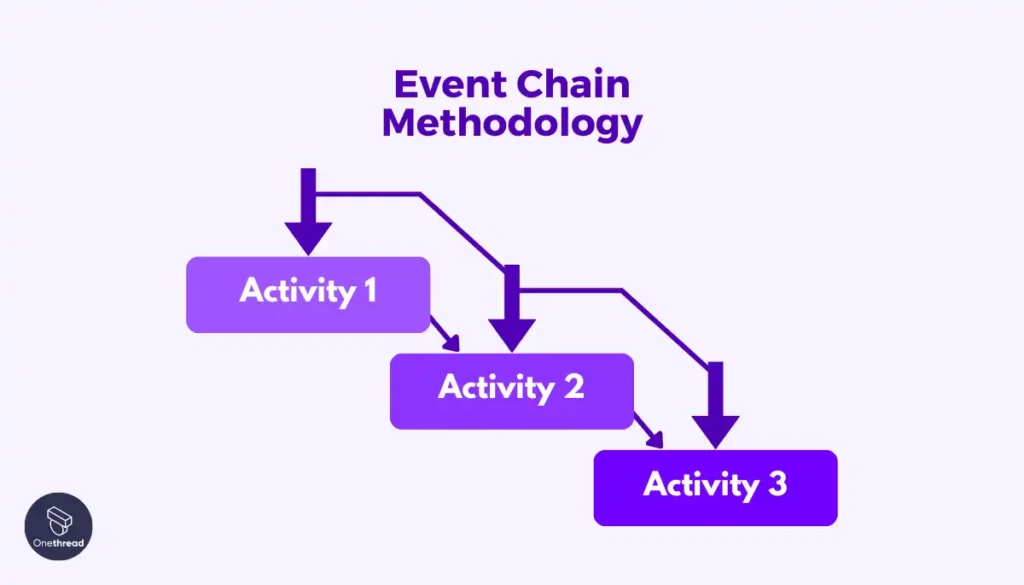
Event Chain Methodology (ECM) is a probabilistic approach to project management that focuses on identifying and managing project risks arising from uncertain events. It utilizes event chains to model and analyze potential project disruptions, allowing project managers to proactively mitigate risks and optimize project outcomes.
Key Aspects
Here are the top aspects of Event Chain Methodology (ECM)
- Risk Management: Prioritizes identifying and mitigating project risks arising from uncertain events to minimize their impact on project objectives.
- Probabilistic Analysis: Utilizes statistical techniques to model and analyze event chains, including their likelihood and potential consequences, to inform risk management decisions.
- Scenario Planning: Anticipates and plans for various project scenarios, including best-case, worst-case, and most likely outcomes, to improve project resilience and flexibility.
Pros
- Improves project risk management and decision-making through probabilistic analysis and scenario planning.
- Increases project resilience and adaptability by proactively addressing potential disruptions and uncertainties.
Cons
- Requires specialized expertise and tools to effectively model and analyze event chains and their impacts on project outcomes.
- May struggle to scale to large, complex projects with numerous interdependencies and uncertainties.
Better Suited For Projects:
Ideal for projects with high levels of uncertainty or complexity, such as research and development initiatives or projects in rapidly changing environments.
Not Suited For Projects:
Less suitable for projects with well-defined requirements or low levels of uncertainty, where traditional risk management approaches may be more appropriate.
Choosing the Right Framework
Choosing the right project management framework is very important. But with so many options, how do you choose the right one? Think about these key factors:
Know your project: What’s it about? Big or small business? Simple or complex? This helps narrow down your options. For example, building a treehouse wouldn’t need the same tools as building a skyscraper!
Meet your team: Are they experienced builders, or do they need training? Some frameworks are easier to learn than others. Remember, happy builders make a smoother ride!
Plan your route: Does your project have clear goals, or might they change along the way? Some frameworks are flexible for unexpected detours, while others like a clear map from start to finish.
Talk it out: How involved will others be in your project? Some frameworks encourage constant feedback, while others focus on clear instructions. Choose one that fits your team’s communication style.
Time and tools: Are you short on time or resources? Some frameworks work faster with fewer tools, while others need more planning and preparation. Pick one that matches your project’s pace and budget.
Remember: There’s no one-size-fits-all framework. Popular ones like Agile and Waterfall offer different approaches. Consider your industry and project type too – some methods work best in specific areas.
Don’t be afraid to adapt: Think of the framework as a starting point, not a rigid rulebook. You can adjust it to fit your project’s needs perfectly.
Get help from a pro: Project management professionals (PMPs) are like expert bike shop owners! They can help you choose the right framework and make sure it works smoothly.
By following these tips, you’ll find the perfect project management framework to build your project successfully and avoid any bumpy rides along the way!
How to Implement a Project Management Framework?
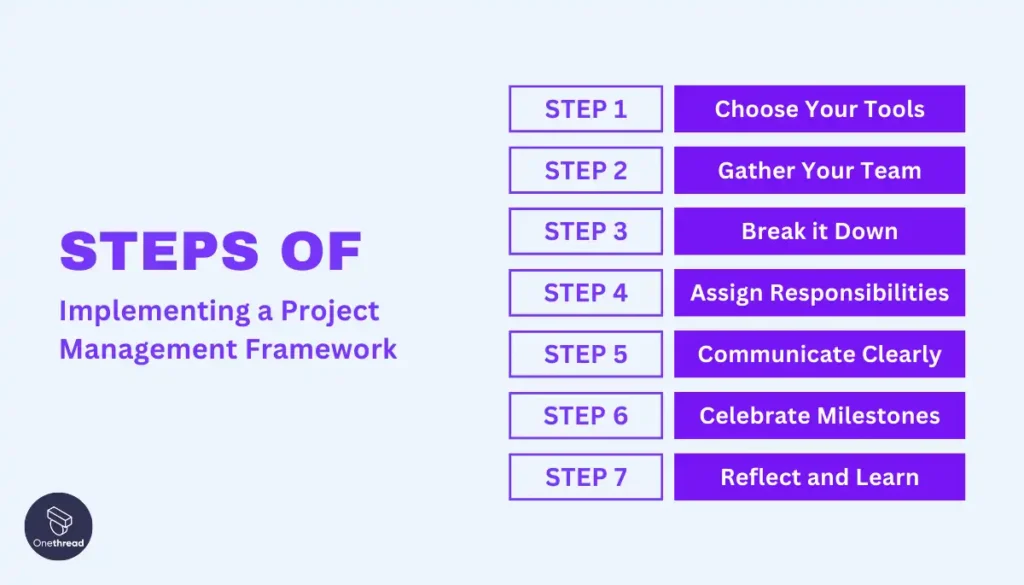
project management framework is like your map and plan for guiding projects from start to finish. So, how do you put this framework into action? Let’s break it down:
Step 1: Choose Your Tools!
Think of it as your toolbox. Popular options are Agile (flexible for changing plans) or Waterfall (great for clear goals). Consider your project’s needs and your team’s style.
Step 2: Gather Your Team:
Talk to your team about the framework and why you chose it. Get everyone excited to build something awesome!
Step 3: Break it Down:
Like building blocks for your treehouse! This makes things less overwhelming and easier to track.
Step 4: Assign Responsibilities:
Give each team member clear tasks and deadlines, just like assigning roles for the treehouse (builder, decorator, etc.).
Step 5: Communicate Clearly:
Use the framework to keep everyone updated on progress, roadblocks, and next steps. Think of it like having daily meetings in your treehouse to share ideas and solve problems.
Step 6: Celebrate Milestones:
Recognize and reward your team’s achievements along the way. It keeps everyone motivated and excited to finish the project.
Step 7: Reflect and Learn:
What worked well? What could be improved next time? This helps you choose the perfect tools and build even better projects in the future!
Remember:
- Be flexible: Your plan might need adjustments, just like your treehouse design might change as you build.
- Have fun! Working together and achieving goals is rewarding, just like building the coolest treehouse on the block!
With these steps and choosing the right framework, you can turn your project into a well-organized, collaborative, and successful endeavor.
Putting your chosen project management framework into action can be daunting.
Onethread helps you every step of the way with its intuitive task management tools, real-time collaboration features, and insightful reports, making project implementation smooth and efficient.
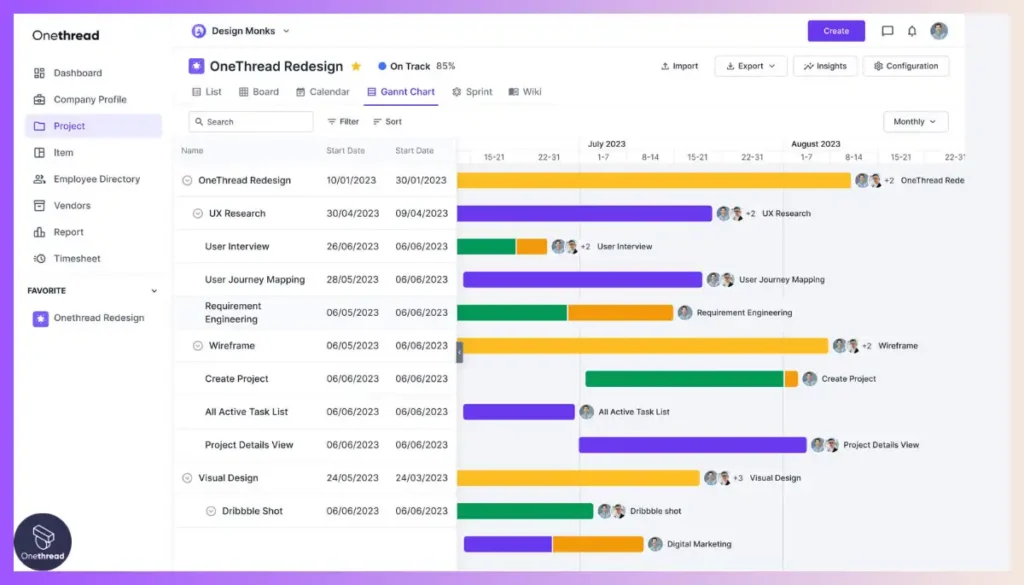
Try Onethread
Experience Onethread full potential, with all its features unlocked. Sign up now to start your 14-day free trial!
The 6Cs of Success with Project Management Frameworks
Let’s go into the magical world of the 6Cs that make these frameworks your project’s best buddy:
- Consistency: Imagine everyone in your team playing a game but following the same rules. That’s what consistency is all about. It makes sure everyone is on the same track, making fewer mistakes and building something awesome together.
- Clarity: This is like having a clear picture on the puzzle box. You know what you’re building towards, so you don’t end up with a spaceship when you were supposed to build a castle.
- Collaboration: Think of your team as a band. Each member plays a different instrument, but together, you create a hit song. Collaboration ensures everyone’s in tune, making the project a chart-topper.
- Continuity: Ever watched a TV series that just gets better with every season? That’s continuity. It means taking the good stuff you learned from the last project and using it to make the next one even cooler.
- Capability: This is about breaking down a big, scary monster into smaller, less scary pieces. It makes tackling challenges feel like a fun game rather than a homework assignment.
- Communication: Imagine if your favorite game characters could talk to you, making the game easier and more fun. That’s what effective communication does. It keeps everyone in the loop, so no one misses out on important updates.
Onethread can help you achieve all of the 6Cs of success with project management frameworks. With its easy-to-use interface and powerful collaboration features, Onethread can help you ensure Consistency, Clarity, Collaboration, Continuity, Capability, and Communication in your projects.
Try Onethread
Experience Onethread full potential, with all its features unlocked. Sign up now to start your 14-day free trial!
The Future of Project Management Frameworks
As we sail into the future, the winds of change are bringing new formats and frameworks to the forefront of project management. Let’s dive into what’s on the horizon and how Onethread is making waves.
The New PMP Format: An Overview
The Project Management Professional (PMP) certification is like the compass for project managers, guiding them through the complexities of their role.
Recently, this compass has been recalibrated to include more agile and hybrid approaches, reflecting the evolving landscape of project management. This shift acknowledges that being adaptable and versatile in project management methodologies is no longer optional; it’s essential.
Latest Trends: Where’s Project Management Headed?
- AI and Automation: Robots are joining the team! AI helps automate tasks, freeing you to focus on bigger things.
- Data-Driven Decisions: Numbers tell the story! Using data insights helps make better, faster decisions.
- Focus on People: Happy builders make happy projects! The future is about collaboration, communication, and keeping your team motivated.
As project management evolves, traditional tools often struggle to keep up. Onethread is designed for the future, offering a flexible and scalable platform that can adapt to your team’s needs and changing demands, ensuring you stay ahead of the curve.
Try Onethread
Experience Onethread full potential, with all its features unlocked. Sign up now to start your 14-day free trial!
FAQs
What are the five phases of the project management framework?
The five phases are conception and initiation, project planning, project execution, performance/monitoring, and project closing. These stages guide a project from the initial idea through to its completion.
What is the most powerful framework?
The most powerful framework depends on the project’s needs. Agile is highly adaptable to changing requirements, while Waterfall is powerful for projects with defined steps and outcomes.
What is SQL framework?
An SQL framework provides a structured way to interact with databases using SQL (Structured Query Language). It helps manage database operations more efficiently and securely.
Thinking about using SQL? You’ll get the most out of them once you learn SQL through training. Building your SQL skills first ensures you can confidently handle queries, joins, and database logic before layering on frameworks.
Is PMP Agile or Waterfall?
PMP (Project Management Professional) certification covers both Agile and Waterfall methodologies. It provides a comprehensive understanding of various project management practices, including both flexible and traditional approaches.
Final Thoughts
Navigating the complexities of project management demands a strategic framework tailored to each project’s unique needs. Embracing adaptability, prioritizing collaboration, and choosing the right tools are essential for success.
As the landscape evolves, solutions like Onethread offer simplicity and affordability, empowering teams to streamline their processes and achieve their project goals efficiently in an ever-changing environment.
